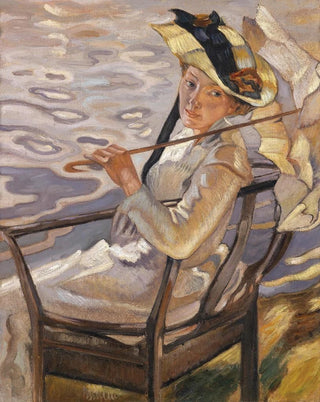Art print | In the Sun - Leo Putz


View from behind

Frame (optional)
Sunlit Art print - Leo Putz – Captivating Introduction
In the vast panorama of modern art, certain works stand out for their ability to capture not only scenes but also deep emotions and vibrant atmospheres. "Sunlit" by Leo Putz embodies this aesthetic quest, offering a striking view of light and nature. This canvas, both simple and complex, evokes a suspended moment where time seems to stand still under the glow of a radiant sun. By contemplating this piece, the viewer is transported into a universe where joie de vivre blends with delicate sensitivity, revealing the magic of a shared instant with the natural world.
Style and uniqueness of the work
Leo Putz's style is characterized by luminous impressionism, where color and light play a central role. In "Sunlit," vibrant brushstrokes and bright hues combine to create a warm and welcoming atmosphere. The artist uses subtle contrasts between shadows and lights, making the elements of the composition almost tangible. The depiction of a sun-drenched landscape, where nature flourishes in all its splendor, demonstrates undeniable technical mastery. Putz manages to convey a sense of movement, as if the wind caressed the foliage and sunbeams danced across the forms. In doing so, he invites the viewer to feel the warmth and vitality of the scene, establishing a strong emotional connection with the artwork.
The artist and his influence
Leo Putz, born in 1869 in Germany, is often regarded as one of the pioneers of impressionism in Europe. His career, marked by travels across Italy and other regions, profoundly influenced his artistic vision. By immersing himself in Mediterranean landscapes and local pictorial traditions, he developed a unique style that combines the lightness of impressionism with romantic sensitivity. Putz was also a fervent advocate of plein air art, firmly believing that nature should be at the heart of every creation. His influence is felt not only in his works but also in how he inspired other artists to explore themes of the

Matte finish

View from behind

Frame (optional)
Sunlit Art print - Leo Putz – Captivating Introduction
In the vast panorama of modern art, certain works stand out for their ability to capture not only scenes but also deep emotions and vibrant atmospheres. "Sunlit" by Leo Putz embodies this aesthetic quest, offering a striking view of light and nature. This canvas, both simple and complex, evokes a suspended moment where time seems to stand still under the glow of a radiant sun. By contemplating this piece, the viewer is transported into a universe where joie de vivre blends with delicate sensitivity, revealing the magic of a shared instant with the natural world.
Style and uniqueness of the work
Leo Putz's style is characterized by luminous impressionism, where color and light play a central role. In "Sunlit," vibrant brushstrokes and bright hues combine to create a warm and welcoming atmosphere. The artist uses subtle contrasts between shadows and lights, making the elements of the composition almost tangible. The depiction of a sun-drenched landscape, where nature flourishes in all its splendor, demonstrates undeniable technical mastery. Putz manages to convey a sense of movement, as if the wind caressed the foliage and sunbeams danced across the forms. In doing so, he invites the viewer to feel the warmth and vitality of the scene, establishing a strong emotional connection with the artwork.
The artist and his influence
Leo Putz, born in 1869 in Germany, is often regarded as one of the pioneers of impressionism in Europe. His career, marked by travels across Italy and other regions, profoundly influenced his artistic vision. By immersing himself in Mediterranean landscapes and local pictorial traditions, he developed a unique style that combines the lightness of impressionism with romantic sensitivity. Putz was also a fervent advocate of plein air art, firmly believing that nature should be at the heart of every creation. His influence is felt not only in his works but also in how he inspired other artists to explore themes of the






